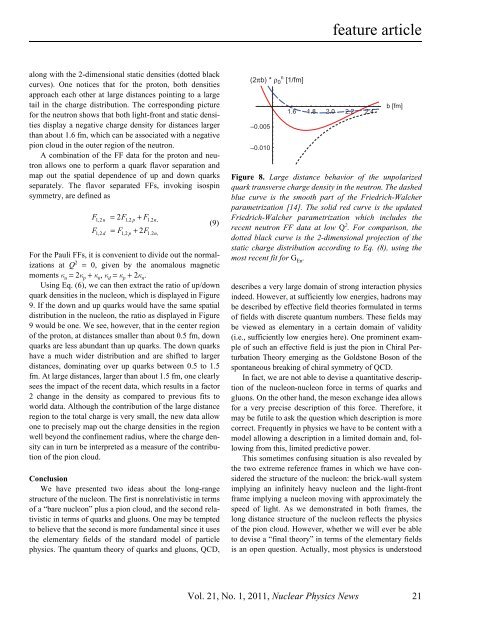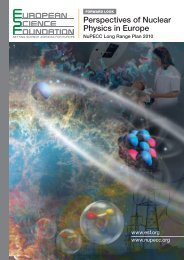Vol. 21 No. 1 - NuPECC
Vol. 21 No. 1 - NuPECC
Vol. 21 No. 1 - NuPECC
You also want an ePaper? Increase the reach of your titles
YUMPU automatically turns print PDFs into web optimized ePapers that Google loves.
feature article<br />
along with the 2-dimensional static densities (dotted black<br />
curves). One notices that for the proton, both densities<br />
approach each other at large distances pointing to a large<br />
tail in the charge distribution. The corresponding picture<br />
for the neutron shows that both light-front and static densities<br />
display a negative charge density for distances larger<br />
than about 1.6 fm, which can be associated with a negative<br />
pion cloud in the outer region of the neutron.<br />
A combination of the FF data for the proton and neutron<br />
allows one to perform a quark flavor separation and<br />
map out the spatial dependence of up and down quarks<br />
separately. The flavor separated FFs, invoking isospin<br />
symmetry, are defined as<br />
F = 2F + F<br />
F = F + 2F<br />
12 , u 12 , p 12 . n,<br />
12 , d 12 , p 12 . n,<br />
For the Pauli FFs, it is convenient to divide out the normalizations<br />
at Q 2 = 0, given by the anomalous magnetic<br />
moments k u = 2k p + k n , k d = k p + 2k n .<br />
Using Eq. (6), we can then extract the ratio of up/down<br />
quark densities in the nucleon, which is displayed in Figure<br />
9. If the down and up quarks would have the same spatial<br />
distribution in the nucleon, the ratio as displayed in Figure<br />
9 would be one. We see, however, that in the center region<br />
of the proton, at distances smaller than about 0.5 fm, down<br />
quarks are less abundant than up quarks. The down quarks<br />
have a much wider distribution and are shifted to larger<br />
distances, dominating over up quarks between 0.5 to 1.5<br />
fm. At large distances, larger than about 1.5 fm, one clearly<br />
sees the impact of the recent data, which results in a factor<br />
2 change in the density as compared to previous fits to<br />
world data. Although the contribution of the large distance<br />
region to the total charge is very small, the new data allow<br />
one to precisely map out the charge densities in the region<br />
well beyond the confinement radius, where the charge density<br />
can in turn be interpreted as a measure of the contribution<br />
of the pion cloud.<br />
Conclusion<br />
We have presented two ideas about the long-range<br />
structure of the nucleon. The first is nonrelativistic in terms<br />
of a “bare nucleon” plus a pion cloud, and the second relativistic<br />
in terms of quarks and gluons. One may be tempted<br />
to believe that the second is more fundamental since it uses<br />
the elementary fields of the standard model of particle<br />
physics. The quantum theory of quarks and gluons, QCD,<br />
(9)<br />
(2πb) * ρ 0 n [1/fm]<br />
–0.005<br />
–0.010<br />
1.6 1.8 2.0 2.2 2.4<br />
b [fm]<br />
Figure 8. Large distance behavior of the unpolarized<br />
quark transverse charge density in the neutron. The dashed<br />
blue curve is the smooth part of the Friedrich-Walcher<br />
parametrization [14]. The solid red curve is the updated<br />
Friedrich-Walcher parametrization which includes the<br />
recent neutron FF data at low Q 2 . For comparison, the<br />
dotted black curve is the 2-dimensional projection of the<br />
static charge distribution according to Eq. (8), using the<br />
most recent fit for G En .<br />
describes a very large domain of strong interaction physics<br />
indeed. However, at sufficiently low energies, hadrons may<br />
be described by effective field theories formulated in terms<br />
of fields with discrete quantum numbers. These fields may<br />
be viewed as elementary in a certain domain of validity<br />
(i.e., sufficiently low energies here). One prominent example<br />
of such an effective field is just the pion in Chiral Perturbation<br />
Theory emerging as the Goldstone Boson of the<br />
spontaneous breaking of chiral symmetry of QCD.<br />
In fact, we are not able to devise a quantitative description<br />
of the nucleon-nucleon force in terms of quarks and<br />
gluons. On the other hand, the meson exchange idea allows<br />
for a very precise description of this force. Therefore, it<br />
may be futile to ask the question which description is more<br />
correct. Frequently in physics we have to be content with a<br />
model allowing a description in a limited domain and, following<br />
from this, limited predictive power.<br />
This sometimes confusing situation is also revealed by<br />
the two extreme reference frames in which we have considered<br />
the structure of the nucleon: the brick-wall system<br />
implying an infinitely heavy nucleon and the light-front<br />
frame implying a nucleon moving with approximately the<br />
speed of light. As we demonstrated in both frames, the<br />
long distance structure of the nucleon reflects the physics<br />
of the pion cloud. However, whether we will ever be able<br />
to devise a “final theory” in terms of the elementary fields<br />
is an open question. Actually, most physics is understood<br />
<strong>Vol</strong>. <strong>21</strong>, <strong>No</strong>. 1, 2011, Nuclear Physics News <strong>21</strong>
















